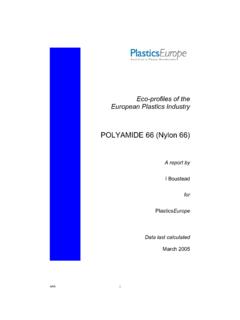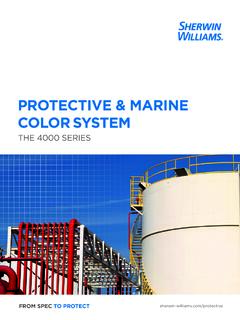Transcription of Introduction to microstructure - Inference
1 Practical 17 Materials and Minerals ScienceCourse C: MicrostructureCP11 Introduction to What is microstructure ?When describing the structure of a material, we make a clear distinction between its crystal structure and its microstructure . The term crystal structure is used to describe the average positions of atoms within the unit cell, and is completely specified by the lattice type and the fractional coordinates of the atoms (as determined, for example, by X-ray diffraction). In other words, the crystal structure describes the appearance of the material on an atomic (or ) length scale. The term microstructure is used to describe the appearance of the material on the nm-cm length scale. A reasonable working definition of microstructure is: microstructure can be observed using a range of microscopy techniques.
2 The microstructural features of a given material may vary greatly when observed at different length scales. For this reason, it is crucial to consider the length scale of the observations you are making when describing the microstructure of a this course you will learn about how and why microstructures form, and how microstructures are observed experimentally. Most importantly, microstructures affect the physical properties and behaviour of a material, and we can tailor the microstructure of a material to give it specific properties (this is the subject of the next course). The microstructures of natural minerals provide information about their complex geological history. microstructure is a fundamental part of all materials and minerals science, and these themes will be expanded on in subsequent practical is in three parts.
3 You should aim to spend a total of 60 minutes on parts 1 and 2, and 60 minutes on part 3. The arrangement of phases and defects within a material. What you should know by the end of the practical! is meant by the terms microstructure , phase , component , and defect of the different processes that can lead to the formation of we observe microstructures experimentally, and how the length scale of the microstructure observed depends on the resolution of the experimental technique principles of imaging and resolutionPractical 17 Materials and Minerals ScienceCourse C: Phase/Component/DefectA phase is taken to be any part of a material with a distinct crystal structure and/or chemical composition. Different phases in a material are separated from one another by distinct pure substance with a uniquely-defined chemical composition is said to consist of one chemical component.
4 The chemical composition of some materials can be varied continuously between two or more extremes (often referred to as endmembers ). These materials must contain, therefore, two or more chemical components. Note that a multi-component material can exist as a single phase if the different chemical components are intimately mixed at the atomic length scale. In the solid state, such mixtures are called solid solutions .A defect is taken to mean any disruption to the perfect periodicity of the crystal structure. This includes point defects such as vacancies and interstitials, planar defects such as surfaces, twin boundaries, and grain boundaries, and as we will investigate in Course D, dislocations.(a) A single crystal of quartz (SiO2)(b) A sheet of galvanized steel (Zn surface layer)(c) An Fe-Ni meteorite(d) A partially crystallised wollastonite (CaSiO3) glass (e) GraniteYou are provided with several photographs and hand specimens.
5 In each case, write down the number of components and phases present, and identify the types of defect (if any) that are present. Make a labelled sketch of each one and add an appropriate scale bar. The examples provided How microstructures formMicrostructures form through a variety of different processes. microstructures are almost always generated when a material undergoes a phase transformation brought about by changing temperature and/or pressure ( a melt crystallising to a solid on cooling). microstructures can be created through deformation or processing of the material ( rolling, pressing, welding). Finally, microstructures can be created artificially by combining different materials to form a composite material ( carbon-fibre reinforced plastic). Here we will examine some examples of microstructures formed by different processes.
6 The materials will be examined using both reflected-light and transmitted-light microscopes. Ask your demonstrators for advice on setting up the two different types of microscope. Guidelines are printed on separate sheets. Remember to look at the materials at a range of magnifications: some microstructural details may only be visible at high magnification!Practical 17 Materials and Minerals ScienceCourse C: MicrostructureCP13 When a melt with limited miscibility between components solidifies, one often finds that different phases solidify at different temperatures on cooling. In some cases, the different phases form contemporaneously and become intimately intergrown with each other to form complex (and often quite beautiful) microstructures . We will meet many examples of this behaviour throughout this ) Phase separation (exsolution, precipitation).
7 A multi-component material can exist as a single phase if the components are intimately mixed ( miscible) at the atomic scale (forming a solid solution). In many materials, miscibility is restricted to a limited range of compositions. The range of miscibility is a strong function of temperature: a material that is happy to form a single phase at high temperature might be forced to unmix into two phases at lower temperature ( the components become immiscible). This process is known as phase separation, exsolution or precipitation. We have already seen a classic example of this phenomenon in the case of the Fe-Ni meteorite in Part 3 shows an example of a slowly cooled multi-component melt with very limited miscibility between components. Different phases formed at different temperatures as the melt was cooled.
8 Make a sketch of the microstructure , paying particular attention to the relationship between different phases ( does one phase appear to fill in the gaps between the other phase?). From your observations, can you deduce the order in which the phases crystallised from the melt? Look carefully at the phases at high magnification. What can you say about the phase that crystallised last?Sample 2 is a micrograph of a material that has exsolved to yield a two-phase intergrowth. What do you notice about the shapes and orientations of the exsolved phases? What could be the reason for these observations?a) Solidification. Solidification of a crystal from a melt occurs through a process of nucleation and growth. Below the freezing temperature, small clusters of atoms in the melt come together through random chance to form a small crystalline particle (a nucleus).
9 The nucleus forms a template onto which other atoms can attach. Each nucleus grows into an individual grain of the crystal. When adjacent grains impinge they form grain boundaries. Since individual nuclei form in different orientations, there is no orientational relationship between adjacent 1 shows the grain microstructure obtained when single-component crystals of olivine (Mg2 SiO4) solidify slowly from a melt. Examine the sample using transmitted light under crossed polars. Make a labelled sketch of the characteristic grain microstructure and add an appropriate scale bar (focus the microscope on a transparent ruler to get an estimate of the field of view). What factors do you think affect the size of the grains? What other microstructural features can you identify?Practical 17 Materials and Minerals ScienceCourse C: Abbe theory of imaging and resolutionYou have met the principles of diffraction from lattice planes in Course A.
10 Here we revise some of the basic concepts and how they relate to the formation of images in a transmission electron microscope (TEM). We will then use the laser benches to explore the resolution of a system. The basic principles of image formation in a microscope (either an optical or an electron microscope) are illustrated in Fig. 1. Fig. 1. Abbe theory of imaging using all diffracted spotsRadiation with wavelength is incident on the object (in this case a diffraction grating with slit spacing d). Each slit in the grating scatters radiation in a variety of directions. Radiation scattered in a given direction is collected by a lens placed at a distance u from the object and focussed into a point in the back focal plane, located at a distance f from the lens. If the condition dsin = n is satisfied (see Course A) then constructive interference occurs and a bright diffraction spot will appear at that point.


